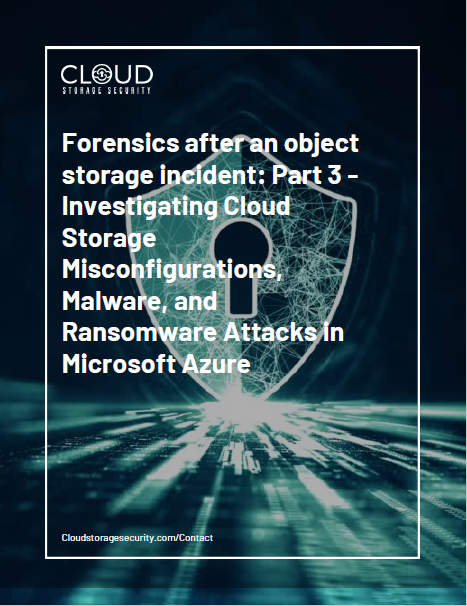Building a Strategy to Secure Your Cloud Storage
Mitigate risks and protect your business with Antivirus for AWS by Cloud Storage Security (CSS).
Forensics after an object storage incident: Part 3 - Investigating Cloud Storage Misconfigurations, Malware, and Ransomware Attacks in Microsoft Azure
Cloud object storage is a prime target for attackers due to the vast amount of sensitive data it holds. This guide provides a focused blueprint for identifying, analyzing, and responding to threats such as malware uploads, storage misconfigurations, and ransomware attacks within Azure environments. Using native tools like Azure Monitor Logs, Storage Analytics, and Microsoft Defender for Storage, alongside NIST 800-61 R3-aligned playbooks, this whitepaper equips security teams to proactively detect threats, execute structured responses, and enhance cloud forensic readiness.

This paper discusses:
Log-based detection and investigation using Azure Activity Logs, Storage Logs, Storage Analytics, and Microsoft Defender alerts to track suspicious access, anomalous deletions, and data exfiltration attempts.
Response playbooks aligned to NIST 800-61 R3, covering containment, eradication, and recovery procedures for malware uploads, misconfiguration-driven exposures, and ransomware events.
The role of Azure Sentinel and SOAR automation in unifying incident management, correlating cross-cloud events, and executing rapid, consistent response actions.
Summarized Excerpt
As organizations increasingly rely on Azure Blob Storage to manage critical information, the threats targeting cloud storage—from misconfigurations to ransomware—have grown in complexity and frequency. Incidents involving public data exposure, unauthorized blob access, and the use of stolen credentials to encrypt or delete files underscore the urgent need for cloud-native forensic readiness.
This guide walks through investigative workflows using Azure-native tools like Storage Logs, VPC Flow Logs, and Defender for Storage alerts. It presents real-world detection strategies and step-by-step playbooks for responding to malware uploads, exposed containers, and ransomware attacks—each mapped to NIST 800-61 R3 phases. It also outlines how integrating Azure Sentinel and SOAR automation improves detection, speeds up response, and ensures cross-team collaboration throughout the incident lifecycle.
By adopting the strategies in this paper, security teams can improve operational resilience, reduce incident impact, and secure the integrity of data stored in Microsoft Azure.
-4.png?width=200&height=130&name=Untitled%20design%20(2)-4.png)